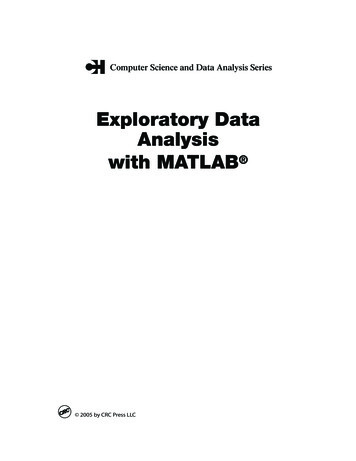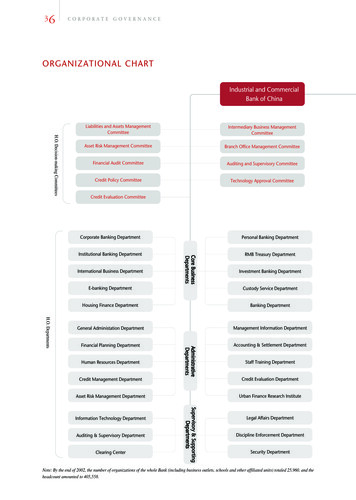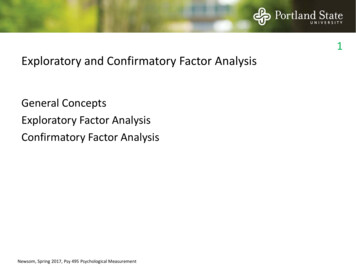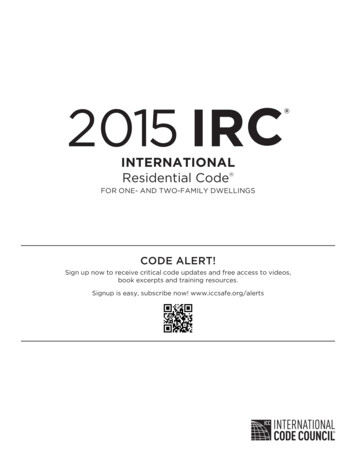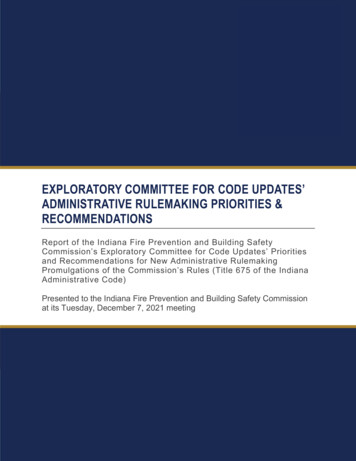
Transcription
EXPLORATORY COMMITTEE FOR CODE UPDATES’ADMINISTRATIVE RULEMAKING PRIORITIES &RECOMMENDATIONSReport of the Indiana Fire Prevention and Building SafetyCommission’s Exploratory Committee for Code Updates’ Prioritiesand Recommendations for New Administrative RulemakingPromulgations of the Commission’s Rules (Title 675 of the IndianaAdministrative Code)Presented to the Indiana Fire Prevention and Building Safety Commissionat its Tuesday, December 7, 2021 meeting
Indiana Fire Prevention & Building Safety Commission’s Exploratory Committee for Code UpdatesReport of Administrative Rulemaking Priorities & RecommendationsOVERVIEWAt its Tuesday, December 1, 2020 and Tuesday, January 5, 2021 meetings, the IndianaFire Prevention and Building Safety Commission (the Commission) formed anexploratory subcommittee – the Exploratory Committee for Code Updates (theCommittee) – and tasked it with reviewing the existing statewide building and fire safetycode adopted by the Commission under Title 675 of the Indiana Administrative Code(675 IAC) and recommending a plan forward for updating the existing codes throughnew administrative rulemaking promulgations under the requirements of the IndianaAdministrative Rules and Procedures Act (see Indiana Code § 4-22-2). The Committeeconducted six (6) meetings between February and November, 2021. Pursuant to theCommittee’s bylaws, the Committee’s review was limited to the following existingbuilding and fire safety codes: the 2014 Indiana Building Code (675 IAC 13-2.6)the 2020 Indiana Residential Code (675 IAC 14-4.4)the 2012 Indiana Plumbing Code (675 IAC 16-1.4)the Indiana Electrical Code, 2009 Edition (675 IAC 17-1.8)the 2014 Indiana Mechanical Code (675 IAC 18-1.6)the 2010 Indiana Energy Conservation Code (675 IAC 19-4)the Swimming Pool Code (675 IAC 20)the 2014 Indiana Fire Code (675 IAC 22-2.5)the 2014 Indiana Fuel Gas Code (675 IAC 25-3)the National Fire Protection Association (NFPA) Standards (675 IAC 28-1)In review of the existing building and fire safety codes listed above and pursuant to the“Duties of the Committee” provided in its bylaws, the Committee now provides theCommission this report of the Committee’s priorities and recommendations for updatingthe existing codes through new administrative rulemaking promulgations, and thereasons why the existing codes must be updated to the latest editions of the nationalmode codes.THE COMMISSION’S MOST RECENT RULEMAKING ACTIONS ON THECODESTo identify which code or codes are most immediately in need of being updated throughnew administrative rulemaking promulgations, the Committee reviewed the history andmost recent rulemaking actions taken by the Commission on each code. Limited to thescope of only the codes listed above, the following table identifies when theCommission took its most recent actions on each code (i.e., when thecode/comprehensive rule first became effective, when the Commission last amended orrepealed any provisions of the code/comprehensive rule (if at all), and when theCommission last readopted the code/comprehensive rule pursuant to the requirementsof Indiana Code § 4-22-2.5):Indiana Fire Prevention andBuilding Safety Commission
Indiana Fire Prevention & Building Safety Commission’s Exploratory Committee for Code UpdatesReport of Administrative Rulemaking Priorities & RecommendationsIndianaAdministrativeCode (IAC)CitationTitle in IndianaAdministrative Code(IAC)Model Code Edition Adoptedby Reference675 IAC 13-2.62014 IndianaBuilding Code675 IAC 14-4.42020 IndianaResidential Code675 IAC 16-1.42012 IndianaPlumbing Code675 IAC 17-1.8Indiana ElectricalCode, 2009 Edition675 IAC 18-1.62014 IndianaMechanical Code675 IAC 19-42010 Indiana EnergyConservation Code675 IAC 20-1.1Indiana SwimmingPool, Spa and WaterAttraction Code,Third Edition, Rule1.1 – GeneralProvisions andDefinitionsIndiana SwimmingPool, Spa and WaterAttraction Code,Third Edition, Rule 2– Public SwimmingPoolsIndiana SwimmingPool, Spa and WaterAttraction Code,International Building Code,2012 Edition, First Printingdated May 2011; A117.1Accessible and UsableBuildings and Facilities, 2009Edition, First Printing2018 InternationalResidential Code for Oneand Two- Family Dwellings,First Printing (August 2017)International Plumbing Code,2006 Edition, SecondPrintingNFPA 70 – NationalElectrical Code, 2008Edition, First PrintingInternational MechanicalCode, 2012 Edition, FirstPrinting (April 2011)ANSI/ASHRAE 90.1 EnergyStandard for BuildingsExcept Low-Rise ResidentialBuildings, 2007 Edition, I-PEditionN/A675 IAC 20-2675 IAC 20-3Indiana Fire Prevention andBuilding Safety CommissionN/AN/AEffective Date (asoriginally published andlater amended) and MostRecent Readoption Date(if any)Effective: 12/1/2014Readoption File Date:8/6/2020Effective: 12/26/2019Effective: 12/24/2012Readoption File Date:7/3/2018Effective: 8/26/2009Readoption File Date:7/17/2015Effective: 12/1/2014Readoption File Date:8/6/2020Effective: 5/6/2010Readoption File Date:10/31/2017Effective: 9/1/1989;Amended: effective4/24/2011; ReadoptionFile Date: 7/2/2019Effective: 9/1/1989;Amended: effective12/26/2002; Amended:effective 4/24/2011Readoption File Date:7/2/2019Effective: 9/1/1989;Amended: effective12/26/2002; Amended:
Indiana Fire Prevention & Building Safety Commission’s Exploratory Committee for Code UpdatesReport of Administrative Rulemaking Priorities & RecommendationsThird Edition, Rule 3– Public Spas675 IAC 20-4Indiana SwimmingPool, Spa and WaterAttraction Code,Third Edition, Rule 4– ResidentialSwimming Pools(REPEALED)N/A675 IAC 20-5Indiana SwimmingPool, Spa and WaterAttraction Code,Third Edition, Rule 5– Water AttractionsNFPA 386 –Standard for PortableShipping Tanks forFlammable andCombustible LiquidsNFPA 1126 –Use of Pyrotechnicsbefore a ProximateAudience2014 Indiana FireCodeN/A675 IAC 222.2-22675 IAC 222.2-26NFPA 386 – Standard forPortable Shipping Tanks forFlammable and CombustibleLiquids, 1990 EditionEffective: 8/7/2010Readoption File Date:10/11/2016Effective: 10/21/2005Readoption File Date:8/4/2011 and 3/10/2017N/A2014 Indiana FireCode, Section 913675 IAC 25-32014 Indiana FuelGas Code675 IAC 28-1-2NFPA 10; Standardfor Portable FireExtinguishersNFPA 1126 – Standard forthe Use of Pyrotechnicsbefore a ProximateAudience, 2001 EditionInternational Fire Code, 2012Edition, First Printing datedMay 2011NFPA 20 – Installation ofStationary Pumps for FireProtection, 2010 EditionInternational Fuel Gas Code,2012 Edition, SecondPrinting dated February2012NFPA 10 – Standard forPortable Fire Extinguishers,2010 Edition675 IAC 28-1-3NFPA 11 – Standardfor Low-, Medium-,and High-ExpansionFoamNFPA 11 – Standard forLow-, Medium-, and HighExpansion Foam, 2005Edition675 IAC 22-2.5Indiana Fire Prevention andBuilding Safety Commissioneffective 4/24/2011;Readoption File Date:7/2/2019Effective: 9/1/1989;Repealed: filed3/25/2011, effective4/24/2011; Moved to 675IAC 14 – IndianaResidential Code,effective 4/24/2011, nowSection R326 of the 2020Indiana Residential Code(675 IAC 14-4.4)Effective: 4/24/2011;Readoption File Date:7/2/2019Effective: 12/1/2014Readoption File Date:8/6/2020Effective: 12/1/2014Readoption File Date:8/6/2020Effective: 12/1/2014Readoption File Date:8/6/2020Effective: 9/22/2006;Amended: effective12/15/2012; ReadoptionFile Date: 7/3/2018Effective: 9/22/2006;Readoption File Date:7/3/2018
Indiana Fire Prevention & Building Safety Commission’s Exploratory Committee for Code UpdatesReport of Administrative Rulemaking Priorities & Recommendations675 IAC 28-1-4675 IAC 28-1-5675 IAC 28-1-6675 IAC 28-1-7675 IAC 28-1-8675 IAC 28-1-9675 IAC 28-110675 IAC 28-111675 IAC 28-112675 IAC 28-113675 IAC 28-114NFPA 12 – Standardon Carbon DioxideExtinguishingSystems,NFPA 13 – Standardfor the Installation ofSprinkler SystemsNFPA 13R –Standard for theInstallation ofSprinkler Systems inResidentialOccupancies up toand Including FourStories in HeightRESERVEDNFPA 15 – Standardfor Water SprayFixed Systems forFire ProtectionNFPA 17 – Standardfor Dry ChemicalExtinguishingSystemsNFPA 17A –Standard for WetChemicalExtinguishingSystemsRESERVEDNFPA 12 – Standard onCarbon DioxideExtinguishing Systems, 2005EditionNFPA 13 – Standard for theInstallation of SprinklerSystems, 2010 EditionNFPA 13R – Standard forthe Installation of SprinklerSystems in ResidentialOccupancies up to andIncluding Four Stories inHeight, 2010 EditionEffective: 9/22/2006Readoption File Date:7/3/2018N/ANFPA 15 – Standard forWater Spray Fixed Systemsfor Fire Protection, 2001EditionNFPA 17 – Standard for DryChemical ExtinguishingSystems, 2002 EditionN/AEffective: 9/22/2006;Readoption File Date:7/3/2018NFPA 17A – Standard forWet Chemical ExtinguishingSystems, 2002 EditionEffective: 9/22/2006;Readoption File Date:7/3/2018N/AN/ANFPA 25 – Standardfor the Inspection,Testing, andMaintenance ofWaterBased FireProtection SystemsNFPA 33 – Standardfor Spray ApplicationUsing Flammableand CombustibleMaterialsNFPA 34 – Standardfor Dipping, Coating,and PrintingNFPA 25 – Standard for theInspection, Testing, andMaintenance of WaterBased Fire ProtectionSystems, 2011 EditionEffective 5/12/2013;Readoption File Date:7/3/2018NFPA 33 – Standard forSpray Application UsingFlammable and CombustibleMaterials, 2003 EditionEffective: 9/22/2006;Readoption File Date:7/3/2018NFPA 34 – Standard forDipping, Coating, andPrinting Processes UsingREPEALED, filed11/15/2012, effective12/15/2012Indiana Fire Prevention andBuilding Safety CommissionEffective: 9/27/2012;Readoption File Date:7/3/2018Effective: 9/27/2012;Readoption File Date:7/3/2018Effective: 9/22/2006;Readoption File Date:7/3/2018
Indiana Fire Prevention & Building Safety Commission’s Exploratory Committee for Code UpdatesReport of Administrative Rulemaking Priorities & Recommendations675 IAC 28-115675 IAC 28-116675 IAC 28-117675 IAC 28-118675 IAC 28-119675 IAC 28-120675 IAC 28-121675 IAC 28-122Processes UsingFlammable orCombustible Liquids(REPEALED)NFPA 37 – Standardfor the Installationand Use ofStationaryCombustionEngines and GasTurbinesNFPA 50 – Standardfor Bulk OxygenSystems atConsumer SitesNFPA 50B –Standard forLiquefied HydrogenSystems atConsumer SitesNFPA 51 – Standardfor the Design andInstallation ofOxygen-Fuel GasSystem for Welding,Cutting and AlliedProcessesRESERVEDFlammable or CombustibleLiquids, 2003 EditionNFPA 51B –Standard for FirePrevention DuringWelding, Cutting, andOther Hot WorkNFPA 52 –Compressed NaturalGas (CNG) VehicularFuel Systems CodeNFPA 58 – LiquefiedPetroleum Gas Code(REPEALED)Indiana Fire Prevention andBuilding Safety CommissionNFPA 37 – Standard for theInstallation and Use ofStationary CombustionEngines and Gas Turbines,2002 EditionEffective: 9/22/2006;Readoption File Date:7/3/2018NFPA 50 – Standard for BulkOxygen Systems atConsumer Sites, 2001EditionNFPA 50B – Standard forLiquefied Hydrogen Systemsat Consumer Sites,1999 EditionEffective: 9/22/2006;Readoption File Date:7/3/2018NFPA 51 – Standard for theDesign and Installation ofOxygen-Fuel GasSystem for Welding, Cuttingand Allied Processes, 2002EditionEffective: 9/22/2006;Readoption File Date:7/3/2018N/AN/ANFPA 51B – Standard forFire Prevention DuringWelding, Cutting, and OtherHot Work, 2003 EditionREPEALED, filed11/15/2012, effective12/15/2012NFPA 52 – CompressedNatural Gas (CNG) VehicularFuel Systems Code, 2002EditionNFPA 58 – LiquefiedPetroleum Gas Code, 2011EditionEffective: 9/22/2006;Readoption File Date:7/3/2018Effective: 9/22/2006;Readoption File Date:7/3/2018Effective: 6/16/2008;Repealed: filed2/21/2014, effective3/23/2014**See Chapter 61 of 2014Indiana Fire Code (675IAC 22-2.5-41), whichadopts NFPA 58 –
Indiana Fire Prevention & Building Safety Commission’s Exploratory Committee for Code UpdatesReport of Administrative Rulemaking Priorities & RecommendationsLiquefied Petroleum GasCode, 2011 EditionEffective: 9/22/2006;Readoption File Date:7/3/2018Effective: 9/22/2006;Readoption File Date:7/3/2018675 IAC 28-123NFPA 59 – Utility LPGas Plant CodeNFPA 59 – Utility LP-GasPlant Code, 2004 Edition675 IAC 28-124NFPA 59A –Standard for theProduction, Storageand Handling ofLiquefiedNatural Gas (LNG)RESERVEDNFPA 59A – Standard forthe Production, Storage andHandling of LiquefiedNatural Gas (LNG), 2001EditionN/AN/ARESERVEDN/AN/ARESERVEDN/AN/ANFPA 72 - NationalFire Alarm andSignaling CodeNFPA 72 - National FireAlarm and Signaling Code,2010 EditionRESERVEDN/AEffective: 9/22/2006;Amended: effective3/23/2014; Errata: filed11/7/2014, effective12/22/2014; ReadoptionFile Date: 7/3/2018N/ANFPA 82 – Standardon Incinerators,Waste and LinenHandling Systemsand EquipmentNFPA 86 – Standardfor Ovens andFurnacesRESERVEDNFPA 82 – Standard onIncinerators, Waste andLinen Handling Systems andEquipment, 2004 EditionEffective: 9/22/2006;Readoption File Date:7/3/2018NFPA 86 – Standard forOvens and Furnaces, 2003EditionN/AEffective: 9/22/2006;Readoption File Date:7/3/2018N/ARESERVEDN/AN/ANFPA 385 –Standard for TankVehicles forFlammable andCombustibleLiquidsRESERVEDNFPA 385 – Standard forEffective: 9/22/2006;Tank Vehicles for Flammable Readoption File Date:and Combustible7/3/2018Liquids, 2000 Edition675 IAC 28-125675 IAC 28-126675 IAC 28-127675 IAC 28-128675 IAC 28-129675 IAC 28-130675 IAC 28-131675 IAC 28-132675 IAC 28-133675 IAC 28-134675 IAC 28-135Indiana Fire Prevention andBuilding Safety CommissionN/AN/A
Indiana Fire Prevention & Building Safety Commission’s Exploratory Committee for Code UpdatesReport of Administrative Rulemaking Priorities & Recommendations675 IAC 28-136675 IAC 28-137675 IAC 28-138675 IAC 28-139675 IAC 28-140NFPA 407 –Standard for AircraftFuel ServicingRESERVEDNFPA 407 – Standard forAircraft Fuel Servicing, 2001EditionN/AEffective: 9/22/2006;Readoption File Date:7/3/2018N/ANFPA 704 –Standard System forthe Identification ofthe Fire Hazards ofMaterials forEmergencyResponseNFPA 1123 – Codefor Fireworks DisplayNFPA 704 – StandardSystem for the Identificationof the Fire Hazards ofMaterials for EmergencyResponse, 2001 EditionEffective: 9/22/2006;Readoption File Date:7/3/2018NFPA 1123 – Code forFireworks Display, 2006EditionNFPA 2001 –Standard on CleanAgent FireExtinguishingSystemsNFPA 2001 – Standard onClean Agent FireExtinguishing Systems, 2004EditionEffective: 9/22/2006;Amended: effective6/16/2008; Errata: filed7/3/2013, effective8/17/2013; ReadoptionFile Date: 7/3/2018Effective: 9/22/2006;Readoption File Date:7/3/2018Indiana Fire Prevention andBuilding Safety Commission
Indiana Fire Prevention & Building Safety Commission’s Exploratory Committee for Code UpdatesReport of Administrative Rulemaking Priorities & RecommendationsTHE COMMITTEE’S PRIORITY RECOMMENDATIONS FOR UPDATINGTHE COMMISSION’S RULESBased on its review of the information provided above and based on its consideration ofreceived public comments concerning the codes (the Commission’s rules), theCommittee took official action at its Thursday, June 10, 2021, meeting to establish itspriorities for updating the codes. The Committee recommends that the Commissionshould update the codes through new administrative rulemaking promulgationsin the following order:Top Priority: Update the Indiana Electrical Code to the most recent edition of the nationalmodel code (NFPA 70 – National Electrical Code).Next Priorities: Update the family of core codes to the most recent editions of the national modelcodes in one comprehensive code update/rule promulgation:o International Building Code Updating to the most recent edition of the International BuildingCode will also include review of the International Existing BuildingCode [in replacement of Chapter of 34 of the currently adoptedbuilding code (675 IAC 13-2.6 – 2014 Indiana Building Code)].o International Fire Codeo International Fuel Gas Codeo International Mechanical Codeo International Plumbing CodeRepeal the National Fire Protection (NFPA) Standards and amendments in 675IAC 28 when the family of core codes are updated to the most recent editions ofthe national model codes.Update the Indiana Energy Conservation Code to the most recent edition ofeither ANSI/ASHRAE 90.1 or the International Energy Conservation Code.Low Priorities: Updating the Swimming Pool Code under 675 IAC 20.Updating the Indiana Residential Code under 675 IAC 14.REASONS FOR UPDATING THE COMMISSION’S RULESAs provided in the Committee’s bylaws, this report is required to identify the reasonswhy the codes recommended to be updated must be updated, and the reasons shalladdress the following:Indiana Fire Prevention andBuilding Safety Commission
Indiana Fire Prevention & Building Safety Commission’s Exploratory Committee for Code UpdatesReport of Administrative Rulemaking Priorities & Recommendations(1) Significant differences between the Commission’s existing rule and the mostrecent edition of the model code being recommended to be adopted.(2) Specific issues the update of the code is designed to address (why the update isneeded).(3) Benefits of updating the rule (direct and indirect).(4) Whether the net effect of adopting the code will result in additional regulation orreduced regulation.(5) The expected fiscal impact of updating the code.(6) Any health or safety concerns being addressed by the rule.To accomplish this task, the Committee worked in conjunction with volunteer industrystakeholders and subject matter experts to analyze and compare the Commission’scurrently adopted codes to the latest editions of the national model codes. Thesevolunteers developed supplemental reports based on their analyses of each code withinthe scope of the Committee’s review, and their supplemental reports were presented tothe Committee at its meeting on Tuesday, September 28, 2021.IMPORTANT NOTE: The Commission is advised that the analyses conducted, and thesupplemental reports developed from the analyses, were intended to be “high-leveloverviews” in nature. More in-depth analyses will be performed if and when theCommission appoints subcommittees to review the latest editions of the national modelcode standards that will be adopted by reference in any rule promulgations.For simplicity and the general organization of this report, these supplemental reports areincorporated as exhibits at the end of this report. In the few instances in which theCommittee does not necessarily recommend updating a code or recommends someother action, a general description of the Committee’s assessment of the code isprovided below.675 IAC 13 – Indiana Building Code (See “EXHIBIT A1” and “EXHIBIT A2” below)Comparison: 2014 Indiana Building Code (2012 International Building Code adoptedby reference) to the 2021 International Building CodePrepared by: EXHIBIT A1 – John Hawkins; Kovert Hawkins Architects, AIA IndianaEXHIBIT A2 – Noah Fehrenbacher; WJE Indianapolis, Indiana StructuralEngineers AssociationIMPORTANT NOTE: In “Exhibit A1,” the “Expected fiscal impact” estimates are colorcoded to indicate an anticipated reduction in construction costs (savings) or ananticipated increase in construction costs. Figures in “red” indicate an anticipatedreduction in construction costs (savings). Figures in “black” indicate an anticipatedincrease in construction costs.Indiana Fire Prevention andBuilding Safety Commission
Indiana Fire Prevention & Building Safety Commission’s Exploratory Committee for Code UpdatesReport of Administrative Rulemaking Priorities & Recommendations675 IAC 14 – Indiana Residential Code (See “EXHIBIT B” below)Comparison: 2020 Indiana Residential Code (2018 International Residential Codeadopted by reference) to the 2021 International Residential CodePrepared by: Christina Collester; RTM Consultants, Inc.As stated above under “The Committee’s Priority Recommendations for Updating theCommission’s Rules,” the Committee determined that updating the current IndianaResidential Code should be a “low priority” for the Commission. As provided in the tableabove under “The Commission’s Most Recent Rulemaking Actions on the Codes,” thecurrent Indiana Residential Code is the 2020 Indiana Residential Code (675 IAC 144.4). The 2020 Indiana Residential Code adopts the 2018 International ResidentialCode, First Printing by reference with the amendments provided in 675 IAC 14-4.4. The2020 Indiana Residential Code became effective on December 26, 2019.Given that the 2020 Indiana Residential Code has been an effective code for nearly twoyears, the Committee encourages the Commission to assess the impact that the 2020Indiana Residential Code has had on the state of Indiana’s industries and the regulatedpublic and determine if rulemaking may be necessary to resolve any perceived issues.Any rulemaking to the 2020 Indiana Residential Code is unlikely to be significant innature, and the Commission should be able complete any rulemaking(s) itself with thesupport of its staff.“Exhibit B,” provided below, provides an overview of the items that were added to the2021 International Residential Code that were not included in the 2018 InternationalResidential Code. As provided in the exhibit, none of the additions warrant acomprehensive rulemaking update to the Indiana Residential Code at this time.675 IAC 16 – Indiana Plumbing Code (See “EXHIBIT C” below)Comparison: 2012 Indiana Plumbing Code (2006 International Plumbing Code adoptedby reference) to the 2021 International Plumbing CodePrepared by: Brenda Dant; Indiana PHCC Association675 IAC 17 – Indiana Electrical Code (See “EXHIBIT D” below)Comparison: Indiana Electrical Code, 2009 Edition (NFPA 70 – National ElectricalCode, 2008 Edition adopted by reference) to NFPA 70 – NationalElectrical Code, 2020 EditionPrepared by: Tim McClintock; National Electrical Manufacturers Association675 IAC 18 – Indiana Mechanical Code (See “EXHIBIT E” below)Indiana Fire Prevention andBuilding Safety Commission
Indiana Fire Prevention & Building Safety Commission’s Exploratory Committee for Code UpdatesReport of Administrative Rulemaking Priorities & RecommendationsComparison: 2014 Indiana Mechanical Code (2012 International Mechanical Codeadopted by reference) to the 2021 International Mechanical CodePrepared by: Brenda Dant; Indiana PHCC Association675 IAC 19 – Indiana Energy Conservation Code (See “EXHIBIT F” below)Comparison: 2010 Indiana Energy Conservation Code (ANSI/ASHRAE 90.1 – EnergyStandard for Buildings Except Low-Rise Residential Buildings, I-PEdition, 2007 Edition adopted by reference) to ANSI/ASHRAE 90.1 –Energy Standard for Buildings Except Low-Rise Residential Buildings, I-PEdition, 2019 Edition and the 2021 International Energy ConservationCodePrepared by: Dan Overbey; Browning Day Mullins Dierdorf, Ball State University, AIAIndianaJoe Yount; RATIO Architects, AIA IndianaDoug Fick; CMTA, Inc., ASHRAE675 IAC 20 – Swimming Pool CodeDuring its meetings and as is referenced above under “The Committee’s PriorityRecommendations for Updating the Commission’s Rules,” the Committee determinedthat updating the Swimming Pool Code under 675 IAC 20 should be a “low priority” forthe Commission, and the Committee does not recommend completing any rulemakingat this time.675 IAC 22 – Indiana Fire Code (See “EXHIBIT G” below)Comparison: 2014 Indiana Fire Code (2012 International Fire Code adopted byreference) to the 2021 International Fire CodePrepared by: Joshua Frost; Zionsville Fire DepartmentOther Local Fire OfficialsIMPORTANT NOTE: In “Exhibit H,” the terms “minimal,” “no impact,” “none,” and“negligible” are intended to be synonymous terms and mean that the change (update) inthe code should create either very little or no fiscal impact.675 IAC 25 – Indiana Fuel Gas Code (See “EXHIBIT H” below)Comparison: 2014 Indiana Fuel Gas Code (2012 International Fuel Gas Code adoptedby reference) to the 2021 International Fuel Gas CodePrepared by: Brenda Dant; Indiana PHCC AssociationIndiana Fire Prevention andBuilding Safety Commission
Indiana Fire Prevention & Building Safety Commission’s Exploratory Committee for Code UpdatesReport of Administrative Rulemaking Priorities & Recommendations675 IAC 28 – National Fire Protection Association (NFPA) StandardsAs provided in the table above under “The Commission’s Most Recent RulemakingActions on the Codes,” the Commission has adopted and amended certain editions ofthe National Fire Protection Association’s (NFPA) standards in Article 28 of its rules(675 IAC 28). Several of the Commission’s adopted NFPA standards in 675 IAC 28 areeditions of the standards that are now several years old, and even decades old in someinstances. It is the Committee’s assessment that the practice of readopting thesestandards and the failure to adopt more current standards, or at least rely on thestandards referenced within the adopted national model codes, has createdunnecessary hardships for several of the state’s industries and poses a significantthreat to the health and life safety of the citizens of Indiana.As stated above under “The Committee’s Priority Recommendations for Updating theCommission’s Rules,” the Committee recommends that the currently adopted NationalFire Protection Association (NFPA) Standards and amendments provided in 675 IAC 28be repealed if and when the Commission updates the family of codes are updated tothe most recent editions of the national model codes, specifically when the IndianaBuilding Code and the Indiana Fire Code are updated to the most recent editions of thenational model codes. To more easily interpret, apply, and enforce these standards, theCommittee recommends that the Commission should simply utilize the standards thatare already referenced within the national model codes. Reliance upon the standardsthat are referenced within the national model codes will also ensure that the standardsare only as outdated as the applicable adopted codes.IMPORTANT NOTE: If and when the Commission repeals the standards andamendments provided in 675 IAC 28 in lieu of adopting the standards referenced withinany adopted national model code, the Commission, or any subcommittee it appoints,will be required to perform an in-depth fiscal impact analysis of the changes betweenthe repealed standards (and their amendments) and the new standards, wherever thestandards apply in the codes.FRAMEWORK FOR ESTABLISHING SUBCOMMITTEES TO COMPLETEPROPOSED RULE PROMULGATIONSTo better organize and manage the rulemaking efforts of the Committee’s code updatepriorities listed above, the Committee recommends that the Commission should form a“steering committee” that will oversee the progress of any code subcommitteesestablished that will be tasked with reviewing national model code standards that will beadopted by reference and ultimately drafting the proposed rules that will be presented tothe Commission for adoption.Indiana Fire Prevention andBuilding Safety Commission
EXHIBIT A1Reference from Model CodePublicationSignificant differences between currentcode and most recent edition202Specific issues the updated code isdesigned to addressUpdated definitions refining thedistinction between a stage and a raisedClarifies that a raised platfrorm mayplatform in assembly occupanciesUpdated definitions of fire and202 preservative treated wood,Definition of penthouse revised to202 include stairwaysDefines lodging houses, expands usespermitted in R4 occupancy310Water supply to fire pumps in tall masstimber buildings403.3Numerous improvements in code404 requirements related to atriumsHealth or safety concernsaddressed by codereduces( 50,000)Clarifies current coderecognizes new lumber treatmenttechnologyn/a( 50,000)Updates code to recognize newtechnologyreduces( 10,000)Clarifies current codereduces( 20,000)Improves current codereduces( 100,000)Improves current codereduces( 100,000)Improves current code, recognizesmarketplace changes( 50,000)Updates code to recognizechanges in marketplace andlicensing regulationsDistilleries, breweries, wineries, storageof beer, distilled spirits, wine in barrels Clarifies code reqiurements foror casks are no longer classified as group occupancies and uses currently notdefined in Indiana code307, 311 H308.3Expected fiscal impacthave horizontal sliding curtainsClarifies that uppermost portion of astairway to a roof is not a storySmall food processingestablishments, such as a bakery orClarification of the occupancy for small catering kitchen less than 2,500 s.f.become a B-occupancy, easing thefood processing establishmentsrequirements for such small-scaleoperations.304.1These have frequently beeninterpreted to be assembly oreducational occupancies under theAddition of training and skillcurrent Indiana code, and have beendevelopment occupancies such asthe subject of a number of pasttutoring centers, and gymnastics studios variances as a result of the stricterclassification.304.1 to Business Group B.Revision of requirements for certaincustodial care facilitiesChange would require additionalregulation or reduced regulation?Aligns with common state licensingrequirements. The changes includedeleting outdated terms used in thecode, and incorporation of new subcategories to more closely align withcommon practices in the marketplace. reducesAllows owner-occupied lodginghouses with five or fewer guest roomsto be regulatedunder residential code.Expands R-4 occupancies to includecustodial carereducesAddresses issue of contribution to fireload of mass timber structuresaddsClarifies requirements for issues suchas egress travel through atriums,smoke control and horizontalassembliesadds( 100,000) 50,000 0Improves current code, recognizesmarketplace changesImproves current code, recognizesmarketplace changes, closesloopholeImproves current code
New sections addressing private garages,including groupings of multiple privategarages such as ones used in some multi406 family housing developmentsShared domestic cooking facilities, andshared living space regulations relaxed407Horizontal doors at stage openings410.3.5Addition of puzzle rooms as a new411.5 occupancy type.allows multiple small private garagesto be grouped and classified as Uoccupancies if separated by fireb
675 IAC 17-1.8 Indiana Electrical Code, 2009 Edition NFPA 70 – National Electrical Code, 2008 Edition, First Printing Effective: 8/26/2009 Readoption File Date: 7/17/2015 675 IAC 18-1.6 2014 Indiana Mechanical Code International Mechanical Code, 2012 Edition, First Printing (April 2011
